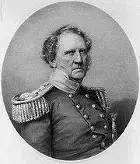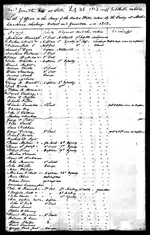goldcoastwayne
Full Member
- Joined
- Apr 22, 2010
- Messages
- 139
- Reaction score
- 1
- Golden Thread
- 0
- Location
- Coral Springs, FL
- Detector(s) used
- Garrett SeaHunter XL500 (PI)
- #21
Thread Owner
bigcypresshunter said:Yes the soldiers and civilians, along with their occupation and family members, living at these forts, are available on line from the census and genealogy sites, if you know where to look...goldcoastwayne said:Also with any of the forts anyone investigates, keep your eyes open for grave markers. With many of these forts I have found logs of the soldiers that resided there. Just give me the name and I will cross-match it to my rosters. That could be a very interesting study in itself. The Florida archives are full of this information, but you have to take the time to investigate it.
Where you able to match up a name or anything that connected this cemetery with Fort Buckeye? I think its a good idea to check the names on the graves.
With Fort Buckeye, I have not physically been to the site...if someone provides names on the grave markers at that site I can add another solid piece of the puzzle. Here is the approach I take:
If anyone cares to investigate grave markers at or near old Florida fort sites (as well as forts in other states), here is a link that is a very good start:
http://www.accessgenealogy.com/forts/florida_frontier_forts_prior_1902.htm
for other states: http://www.accessgenealogy.com/forts/index.htm
Just keep in mind that the listing of early forts in Florida gives general information of the fort locations...some of them do not coincide with other information I have gathered.
Instead of going through the National Military Records, I prefer a "back door approach"....when you find a grave marker (or preferably several) search by the name and then by military records or military history....here is an example: (There is an annual fee for the use of these searches)
Major General Winfield Scott (prominent figure in the Seminole wars)
http://nativeamericanfirstnationshistory.suite101.com/article.cfm/setbacks_in_florida
From here you can dig even deeper in the geneological site that I gave you a link to and from there into US Military original documents :
U.S. Civil War Soldier Records and Profiles U.S. Civil War Soldier Records and Profiles
Name: Winfield Scott
Occupation: US Army Officer
Age at Enlistment: 55
Enlistment Date: 25 Jun 1841
Rank at enlistment: Major General
State Served: Regular Army
Survived the War?: Yes
Service Record: Commissioned an officer in the Regular Army General Staff Infantry Regiment on 25 Jun 1841.
Promoted to Brevet Lt General on 29 Mar 1847.
Mustered out on 01 Nov 1861.
Birth Date: 13 Jun 1786
Death Date: 29 May 1866
Death Place: West Point, NY
Sources: Dyer: A Compendium of the War of the Rebellion
Heitman: Register of United States Army 1789-1903
Generals in Blue, Lives of the Union Commanders
Photo courtesy of Mike Medhurst
Biography: WINFIELD SCOTT
Scott, Winfield, major-general, was born in Petersburg, Va., June 13, 1786. After spending two years in William and Mary college he studied law, was admitted to the bar in 1806, and the following year went to Charleston with the intention of settling there, but before he had fairly entered upon the practice of his profession, Congress in view of imminent hostilities with England, passed a bill to enlarge the army and he obtained a commission as captain of light artillery and entered upon his career as a soldier. Recruiting a company he was stationed at Baton Rouge, La., in the division commanded by Gen. Wilkinson. War having been declared against Great Britain in June, 1812, Capt. Scott was made a lieutenant-colonel in the 2nd artillery the following month, and was stationed at Black Rock with two companies of his regiment. Taking part in the battle of Queenstown heights, the field was at first won under his direction; but it was finally lost and himself and his command taken prisoners, from the refusal of the troops at Lewiston to cross to their assistance. Exchanged in Jan., 1813, immediately after the capture of York, Upper Canada, Scott rejoined the army on the frontier as adjutant to Gen. Dearborn, with the rank of colonel. He took part in the expedition against Fort George; landed his men in good order and scaled a steep height in the presence of the enemy, carrying the position at the point of the bayonet. He served well in Wilkinson's campaign, was made a brigadier-general in March, 1814, and immediately thereafter established a camp of; instruction at Buffalo, where his own and other officers were drilled into thorough and accurate discipline. He now served a vigorous and brilliant campaign, being present at the taking of Fort Erie, winning the battle of Chippewa, and doing good service at Lundy's lane, where he was twice severely wounded. For his gallant conduct Scott was brevetted major-general, his commission dating July 25, 1814, the day of the battle of Lundy's lane. He also received a gold medal from Congress and was tendered a position in the cabinet as secretary of war, which he declined. He led the troops in the Black Hawk war of 1832, and the latter part of the same year went south to command the national troops at Charleston and elsewhere, during the nullification excitement, where his prudence, tact, and discretion, saved the country from what seemed the inevitable danger of intestine war. In 1835 he was ordered to Florida, but recalled and employed in the Creek war, and afterward sent before a court of inquiry, but dismissed with honor. In the frontier troubles connected with the Canadian rebellion of 1837, and subsequently with the disputes two years later on the northeastern boundary line, and with the removal of the Cherokees from Georgia in the 30's, Gen. Scott was efficient, conciliating and useful, as an officer and negotiator. In 1841, upon the death of Gen. Macomb, Gen. Scott was placed at the head of the army as general-in-chief, with full rank as major-general, and upon the outbreak of the war with Mexico he was ordered thither. The battles of Palo Alto, Resaca de la Palma, and Monterey having been fought he took the field in time for the projected capture of Vera Cruz, which he invested on March 12, 1847, commencing the bombardment on the 22nd. On the 26th overtures of surrender were made, and ten days later the army moved on to Mexico, defeated the Mexican army under Gen. Santa Anna, at Cerro Gordo on April 18; entered Jalapa the day after; occupied the strong castle and town of La Perote on the 22nd, and the city of Puebla May 15. Contreras, San Antonio, and Churubusco, strong fortifications, were each taken in turn at the point of the bayonet, Molino del Rey and Casa de Mata, dependencies of Chapultepec, were carried by assault on Sept. 8, and, after a determined siege of several days a breach was finally effected in the strong walls of the military college at the castle of Chapultepec, and the following night Santa Anna marched out with the small remnant of his army, and the city of Mexico was at the mercy of Scott. This virtually ended the war, and the honors bestowed upon the successful commander by his country were numerous and enthusiastic, and included a vote of thanks by Congress. In 1848 Gen. Scott was a candidate for the Whig nomination for the presidency, and in 1852 was nominated, but he was defeated at the election by Gen. Franklin Pierce. In Feb., 1855, he was brevetted lieutenantgeneral, to take rank from March 29, 1847, in commemoration of his bravery in Mexico. The Civil war found him still in command of the army, and every inducement was offered him by the South to join their cause; but his loyalty was proof against them, and he threw the weight of his well-earned reputation upon the side of the government. During the early part of the war Gen. Scott was much in consultation with the government, and did his best to perform his official duties as general-in-chief, but he was now too infirm for so colossal a charge, and on Oct. 31, 1861, he retired from office, retaining, by special act of Congress, his pay and allowances. He died at West Point, N.Y., on May 29, 1866.
Source: The Union Army, vol. 8
goldcoastwayne







